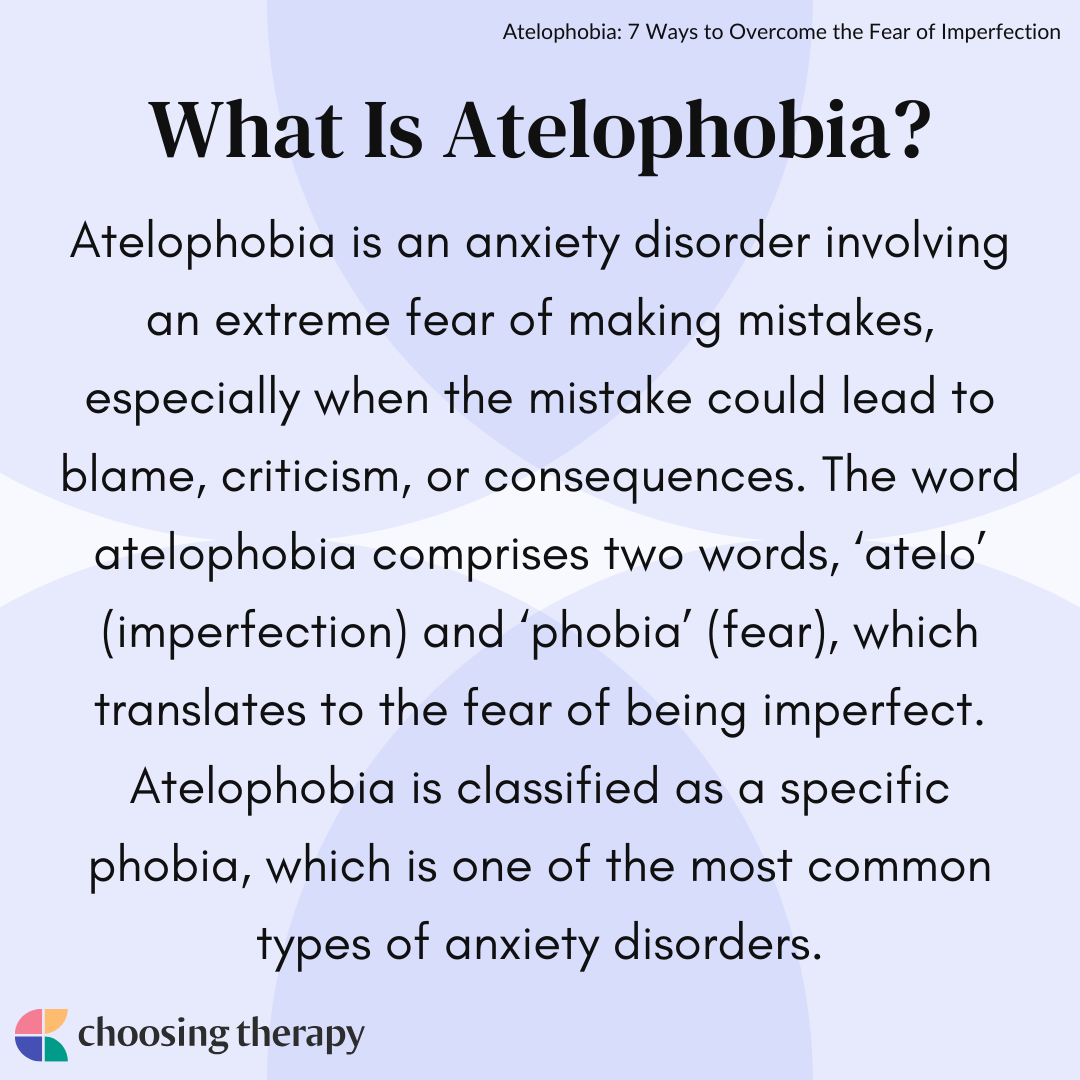Atelophobia Definition: Meaning, Causes, Treatment, and Symptoms
Definition and Description
Definition and Description: Understanding Atelophobia and its Impact
Atelophobia is a complex and lesser-known fear that can have a profound impact on an individual’s life. At its core, atelophobia is an excessive or irrational fear of imperfection, creating a self-fulfilling prophecy where anxiety around not meeting unattainable standards leads to self-doubt and criticism.
Imagine being a perfectionist in every aspect of your life, from your work and relationships to your creative expressions. Sounds impressive, right? Unfortunately, for someone struggling with atelophobia, this “perfectionism” becomes an insidious foe. It makes even the smallest mistakes feel catastrophic, stemming from deep-seated self-criticism due to past failures and perceived shortcomings.
For example, Sarah, a highly ambitious artist, struggles with the overwhelming fear of sharing her work, believing that exposing any imperfection will lead to ridicule and rejection. This crippling fear traps individuals in a relentless cycle of evaluation, perceiving flaws as signs of inadequacy instead of opportunities for growth. The paradox of atelophobia is that it’s not about being “perfect” but rather an internal fear of never being “enough.”
The good news is that atelophobia can be addressed and overcome. Self-awareness, empathy, and understanding the root causes can help individuals reframe their relationship with imperfection—learning to “start and finish” imperfectly rather than striving for perfection.

Atelophobia: In Depth Overview
Atelophobia is a pervasive mental health concern affecting numerous individuals worldwide. This fear, while seemingly harmless, can manifest in debilitating ways that impact self-esteem, relationships, and quality of life.
The Root of Fear
Atelophobia often stems from deep-seated insecurity and a relentless pursuit of perfection. Unrealistic societal expectations, parental or educational pressures, and traumatic experiences can trigger this fear, leading to a feeling of inadequacy with every mistake.
Case Study: Emily’s Struggle with Atelophobia
Emily, a talented graphic designer, is plagued by her fear of producing anything less than flawless work. This expectation creates an all-consuming force in her life, leading to anxiety and self-doubt. However, she learns that perfection is not a prerequisite for creativity, ultimately reframing her relationship with her art.
Breaking Free from the Cycle
Overcoming atelophobia involves a multifaceted approach, including self-awareness and embracing imperfection. Individuals can challenge unrealistic expectations, develop coping strategies, cultivate self-acceptance, and embrace vulnerability for growth.
Therapeutic Intervention and Recovery
Effective treatments like cognitive-behavioral therapy (CBT) and acceptance and commitment therapy (ACT) help individuals manage atelophobia. Recognizing that perfection is unattainable is crucial in healing, allowing a compassionate relationship with oneself.
Conclusion
Atelophobia is a silent yet pervasive mental health concern affecting many lives. Understanding its origins and impact is vital to promoting awareness, self-acceptance, and embracing imperfection as a facet of human experience.
Related Terms and Concepts
Understanding the Complexities of Fear of Imperfection
Atelophobia intersects with various psychological concepts worth exploring:
1. Perfectionism
Perfectionism drives atelophobia, often internalizing unrealistic standards and leading to self-criticism.
2. Self-Acceptance
Cultivating self-compassion is essential in overcoming atelophobia, allowing individuals to embrace their flaws.
3. Fear of Failure
Linked to atelophobia, individuals preoccupied with imperfection often fear failing to meet expectations.
4. Dichotomous Thinking
This cognitive pattern limits growth by viewing experiences as either “perfect” or “imperfect.”
5. Existential Anxiety
Individuals with atelophobia may experience heightened existential anxiety due to their fear of imperfection.
6. Trauma and its Impact on Atelophobia
Past traumas can create coping mechanisms that perpetuate perfectionism, reinforcing atelophobia.
7. Treatment and Recovery
Cognitive-behavioral therapy effectively helps individuals challenge negative thought patterns associated with atelophobia, fostering a healthier self-image.
Examples of Atelophobia in Practice
Atelophobia can manifest in various ways:
Perfectionism in Relationships
Emma, a successful businesswoman, struggles with her fear of inadequacy, micromanaging interactions out of the fear of not meeting her loved ones' needs.
Work-Related Imposter Syndrome
Alex, a talented engineer, feels like an imposter despite his credentials, fearing his work is not good enough.
Creative Blocks and Self-Sabotage
Jamie, a writer, becomes paralyzed by his fear of imperfection, stunting his creative growth.
Mental and Physical Symptoms
Sarah, a college student, experiences severe anxiety led by her obsession with failing, resulting in physical symptoms like IBS and insomnia.
Overcoming Atelophobia
Atelophobia is treatable, with therapies offering coping strategies and support through challenges.
If you or someone you know struggles with atelophobia, consider using tools available on GoblinX for anxiety and ADHD support. You can explore more about GoblinX on their website for helpful resources.
Key Aspects of Atelophobia and Treatment Options
Atelophobia is characterized by intense fear of imperfection and can significantly impact lives. Understanding its aspects and treatment options is crucial for effective recovery.
What is Atelophobia?
It results in anxiety when confronted with possible mistakes, leading to avoidance in personal and professional realms.
Key Aspects of Atelophobia
- Perfectionistic tendencies: Unrealistically high expectations breed disappointment.
- Fear of failure: Deep-seated issues stemming from past experiences.
- Self-criticism: Increasing anxiety through self-blame.
- Rumination: Overthinking perpetuates fears.
Treatment Options for Atelophobia
- Cognitive-behavioral therapy (CBT): Identifying and challenging negative patterns.
- Exposure therapy: Gradual exposure aids desensitization.
- Mindfulness therapies: Encourage acceptance of imperfections.
- Medication: May alleviate anxiety symptoms, best paired with therapy.
Case Study: Recovering from Atelophobia
Emily’s journey illustrates the effectiveness of therapy in tackling atelophobia. Through personalized therapy, she learned to view mistakes as growth opportunities, making her confident in expressing her unique artistic voice.
Conclusion
Recovery from atelophobia is achievable with compassion and support. The right treatments can help overcome perfectionistic tendencies and allow individuals to embrace their authentic selves.
Atelophobia: A Road to Recovery
If you are struggling with atelophobia, understanding your fear, recognizing its impact on daily life, and embracing flaws as part of human experience can guide you to recovery.
Working with professional help, such as therapy and the tools from GoblinX, can also relieve pressures associated with this phobia. To learn more about managing anxiety and ADHD, explore the resources available at GoblinX on their website.